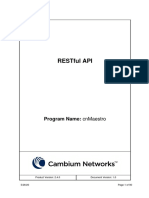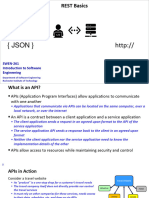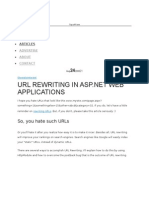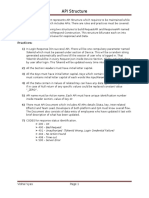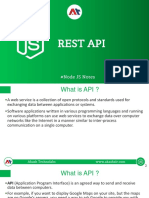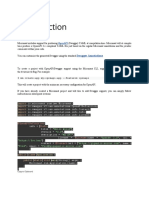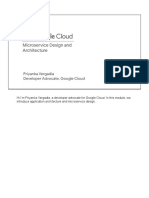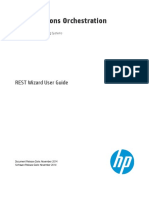Professional Documents
Culture Documents
Web API Best Practices
Web API Best Practices
Uploaded by
Hernan JassoOriginal Description:
Copyright
Available Formats
Share this document
Did you find this document useful?
Is this content inappropriate?
Report this DocumentCopyright:
Available Formats
Web API Best Practices
Web API Best Practices
Uploaded by
Hernan JassoCopyright:
Available Formats
ASP.
NET Core
Web API Best Practices
STEVE SMITH
ARDALIS.COM | @ARDALIS | STEVE@ARDALIS.COM
WEEKLYDEVTIPS.COM (PODCAST)
Web API Best Practices - @ardalis
Learn More After Today
1) DevIQ
◦ ASP.NET Core Quick Start http://aspnetcorequickstart.com
2) Microsoft FREE eBook/Sample App
◦ eShopOnWeb eCommerce Sample https://ardalis.com/architecture-ebook
3) Weekly Dev Tips Podcast / Newsletter
◦ http://ardalis.com/tips
4) Contact me for mentoring/training for your company/team
◦ http://ardalis.com
Web API Best Practices - @ardalis
Web API Design
Web API Best Practices - @ardalis
Representational State Transfer (REST)
"An architectural style for building distributed systems based on hypermedia"
Open standards-based
Technology-agnostic
Client issues a request to a URI that represents a resource;
◦ Request verb that indicates the operation to perform on the resource.
◦ Request body includes the data required for the operation.
REST-based APIs are stateless; each request may be handled by a different server-side resource
https://docs.microsoft.com/en-us/azure/architecture/best-practices/api-design
Web API Best Practices - @ardalis
URI Design Considerations
URI values should correspond to nouns
◦ E.g. /customers, /authors, /orders
URI values should typically be plural (when referring to collections)
◦ Again, /customers, /authors, /orders
Requests for individual resources should append an identifier:
◦ Example: /customers/1, /orders/00234
Web API Best Practices - @ardalis
Principle of Least Astonishment
Try not to surprise your client with how your API works!
Keep it SIMPLE
Keep it CONSISTENT
Web API Best Practices - @ardalis
Don’t Expose Business/Data Model
Avoid coupling your Web API directly to your data/domain model
API design, including URIs, may not map 1:1 to domain objects or database tables.
Example:
POST /orders
May map to a NewOrderRequest on the server that triggers processing payment, checking
inventory, sending notifications, etc.
Or it could just insert a record in the Orders table.
It should be able to do either without the API changing.
Web API Best Practices - @ardalis
Use a standard URI structure for
subcollections
For performance or other reasons, API might not return full object tree with root-level request:
GET /customers/1
{
"id":"1",
"name": "Steve Smith"
}
To get the customer’s orders:
GET /customers/1/orders
[{"id":"123","customerId":"1", …}, {"id":"234","customerId":"1", …}]
Web API Best Practices - @ardalis
Avoid Deeply Nested URI Structures
OK
/customers
/customers/1
/customers/1/orders
TOO MUCH
/customers/1/orders/123 (instead: /orders/123)
/customers/1/orders/123/items/1/products/2 (instead: /products/2)
Web API Best Practices - @ardalis
Hypermedia as the Engine of Application
State (HATEOAS)
Less commonly implemented aspect of REST approach
Currently no widely used standard
Basic idea: Each response includes links defining available requests on a given resource
Example:
GET /customers/1
Response includes customer data, as well as links to:
Update the customer Delete the customer List customer orders
List customer addresses Add an address Add an order
Web API Best Practices - @ardalis
HATEOAS Example - RFC 5988 (web linking)
GET /customers/1
RESPONSE:
{
"id":"1",
"name": "Steve Smith",
"links" : [
"href" : "1/orders",
"rel" : "orders",
"type" : "GET"
]
} https://restfulapi.net/hateoas/
Web API Best Practices - @ardalis
Standard Verbs and Behaviors
GET Fetch a resource (or collection of resources)
PUT Update a resource.
POST Create a new resource.
DELETE Delete a resource.
Web API Best Practices - @ardalis
Safe and Idempotent API Requests
Safe requests are requests that do not change resources, and which can be made repeatedly
without impact. Think of safe requests as read-only operations.
An idempotent HTTP method can be called multiple times without changing the expected
response.
Are these the same?
Web API Best Practices - @ardalis
HTTP Verb Idempotency/Safety
VERB Idempotent? Safe?
GET Yes Yes
PUT Yes No
POST No No
DELETE Yes* No
*Decide if a DELETE for a missing id should return a 404 or not. If it returns 404, it won’t be Idempotent.
http://restcookbook.com/HTTP%20Methods/idempotency/
Web API Best Practices - @ardalis
Web API
Implementation
Web API Best Practices - @ardalis
Use Model Validation (up to 2.0)
Always check if Model.IsValid before performing unsafe operations
Web API Best Practices - @ardalis
Use Filters To Represent Policies
Validate Model State using a filter (globally, per-controller, or per-action)
Web API Best Practices - @ardalis
Use [ApiController] in 2.1+
Performs model validation automatically
Requires attribute routing
Recommendation: Add to a base API controller class
Alternately in 2.2 can be applied to Startup for whole project
Web API Best Practices - @ardalis
Base Class
Inherit from ControllerBase, not Controller
Create your own BaseApiController like this one (consider also adding Authorize
filter):
Web API Best Practices - @ardalis
Use Proper HTTP Status Codes as Results
200 OK Request was successful; body has response.
201 OK POST or PUT was successful; body has latest representation.
204 OK DELETE was successful; resource was deleted.
400 BAD REQUEST The request was invalid or cannot otherwise be served.
401 UNAUTHORIZED Authorization failed or authentication details not supplied.
404 NOT FOUND The URI requested or the resource requested doesn’t exist.
500 Internal Server Error Something very bad happened. Unhandled exceptions lead to this.
Web API Best Practices - @ardalis
Web API Conventions
Scenario Expected Response
Get Object with ID – Object Found 200 OK
Get Object with ID – No such object 404 Not Found
Create Object – Object is valid 200 OK
Create Object – Object is invalid 400 Bad Request
Update Object – Object exists and new object is valid 200 OK
Update Object – No such object 404 Not Found
Update Object – New object is invalid 400 Bad Request
Delete Object with ID – Deletion successful 200 OK
Delete Object with ID – No such object 404 Not Found or 200 OK
Web API Best Practices - @ardalis
Prefer NotFound to
NullReferenceException
Web API Best Practices - @ardalis
Prefer NotFound to
NullReferenceException
Web API Best Practices - @ardalis
Use a filter to confirm existence
Web API Best Practices - @ardalis
Avoid Duplicating Data within Requests
Don’t ask for an ID in the route and also in the BindingModel
◦ Unless you’re going to allow updates to a resource’s ID!
Which value should you use? How do you decide?
◦ Best to use a model type that doesn’t include the ID if it’s redundant
Web API Best Practices - @ardalis
Use DTOs Appropriately
Avoid using domain objects or data entities as your API inputs or outputs.
◦ Doing so exposes your app’s internal state and can be a security risk
Avoid creating DTO types that inadvertently reference non-DTO types.
◦ Tip: Look for using statements in your DTO files that shouldn’t be there
If specifying ID on DTOs, may not make sense to use for new object requests (POSTs)
◦ Consider having separate NewResourceDTO and ResourceDTO types
◦ ResourceDTO can inherit from NewResourceDTO and simply add the Id property
Web API Best Practices - @ardalis
Entity Class – Used in POST Action
public class GuestbookEntry : BaseEntity
{
public string EmailAddress { get; set; }
public string Message { get; set; }
public DateTimeOffset DateTimeCreated { get; set; } = DateTime.UtcNow;
}
Intended behavior is only EmailAddress and Message are sent by post.
Web API Best Practices - @ardalis
Security Issue: Data Object for API
Web API Best Practices - @ardalis
Example: Create/Update DTOs
public class NewCustomerDTO
{
public string Name { get; set; }
public string EmailAddress { get; set; }
}
public class CustomerDTO : NewCustomerDTO
{
public int Id { get; set; }
}
Web API Best Practices - @ardalis
Non-DTOs May Expose Sensitive Data
Web API Best Practices - @ardalis
Post-Redirect-Get (PRG) Pattern
Overview
◦ Client POSTs to Server
◦ Server performs requested operation and returns a Redirect (302) to new URI
◦ Client GETs new URI
This pattern is most appropriate to MVC non-API apps.
◦ One of its primary benefits is that it eliminates browser refreshes from reissuing POST commands.
◦ Not generally an issue with Web APIs
REST services should (typically) return the resource in the body of POST commands, not
redirect
Web API Best Practices - @ardalis
What to Return?
Object
◦ Author, Customer, or void
◦ Automatically wrapped in a result (or
Encoding-Specific
◦ return Json(model); // JsonResult
IActionResult (2.0 and earlier) or ActionResult<T> (v2.1+)
◦ return Ok(model);
◦ return NotFound();
◦ return BadRequest();
Web API Best Practices - @ardalis
Prefer IActionResult or ActionResult<T>
Support Content Negotiation
Requests can include Accept header specifying content they want/support
Web API will attempt to comply with specified content format
Support JSON (default) and XML:
Add XML Serializers when adding MVC in ConfigureServices:
services.AddMvc()
.AddXmlSerializerFormatters();
Web API Best Practices - @ardalis
Content Negotiation In Action
Web API Best Practices - @ardalis
Content Negotiation In Action
Web API Best Practices - @ardalis
Documentation / Discoverability
Swagger http://swagger.io
Now the OpenAPI Specification
Provide live, runtime documentation of your APIs
Ability to generate client libraries to assist in consuming your API
◦ NSwag - https://github.com/RSuter/NSwag
Web API Best Practices - @ardalis
Adding Swagger to your Web API
Add Nuget package Swashbuckle.AspNetCore
Add Services in ConfigureServices:
services.AddSwaggerGen(c =>
{
c.SwaggerDoc("v1", new Info { Title = "My API", Version = "v1" });
});
Add Middleware to Configure() (next slide)
Web API Best Practices - @ardalis
Adding Swagger to your Web API (cont.)
public void Configure(IApplicationBuilder app)
{
app.UseSwagger(); // Enable middleware to serve generated Swagger as a JSON
endpoint.
// Enable middleware to serve swagger-ui specifying the Swagger JSON
endpoint.
app.UseSwaggerUI(c =>
{
c.SwaggerEndpoint("/swagger/v1/swagger.json", "My API V1");
});
app.UseMvc();
}
Web API Best Practices - @ardalis
Response Types Produced
Web API Best Practices - @ardalis
Analyzers
Web API Best Practices - @ardalis
NSwag Studio
Web API Best Practices - @ardalis
Demo
WORKING WITH SWAGGER
Web API Best Practices - @ardalis
Testing Web APIs
Web API Best Practices - @ardalis
Kinds of Tests
Unit Tests
◦ Test a single unit – typically a method
◦ Only test your code, not infrastructure
◦ Limited usefulness for testing APIs
Integration Tests
◦ Test several methods and/or classes working together
◦ Useful for verifying infrastructure code works correctly
Functional Tests
◦ Test full application stack
◦ Slowest, often most brittle, but provide greatest confidence a particular user scenario works fully
Web API Best Practices - @ardalis
Web API Best Practices - @ardalis
Web API Best Practices - @ardalis
Test APIs with TestServer
Install Microsoft.AspNetCore.TestHost Nuget Package
Configure with WebHostBuilder; use HttpClient to make requests to TestServer instance
Learn more:
https://docs.microsoft.com/en-us/aspnet/core/test/integration-tests?view=aspnetcore-2.2
Web API Best Practices - @ardalis
Example Web API Test
Web API Best Practices - @ardalis
Demo
VALIDATING FILTERS PRODUCE SAME RESULTS AS INLINE CODE
Web API Best Practices - @ardalis
Versioning Web APIs
Web API Best Practices - @ardalis
No Versioning
Limit updates to non-destructive wherever possible
Coordinate with clients on breaking changes
Works best with internal APIs
Web API Best Practices - @ardalis
URI Versioning
Example: api.domain.com/v2/customers/1
Previous versions work as before
Results in multiple URIs corresponding to same resource
Can complicate HATEOAS links
Can be unwieldy if API evolves quickly/frequently
Web API Best Practices - @ardalis
Querystring Versioning
Example: api.domain.com/customers/1?ver=2
Previous versions work as before (default to 1 if omitted)
Can complicate HATEOAS links
Can be unwieldy if API evolves quickly/frequently
Web API Best Practices - @ardalis
Header Versioning
Example: GET api.domain.com/customers/1
Version-Header: 2
Previous versions work as before (default to 1 if omitted)
HATEOAS links must use same header
Can be unwieldy if API evolves quickly/frequently
Web API Best Practices - @ardalis
Media Type Versioning
Example: GET api.domain.com/customers/1
Accept: vnd.domain.v2+json
Response includes header indicating version provided
Previous versions work as before (default to 1 if omitted)
Works well with HATEOAS links (can include MIME types)
Web API Best Practices - @ardalis
Versioning Considerations
Consider performance impact, especially for web server and proxy server caching.
◦ Header and Media Type versioning is less cache friendly than other techniques
Consider whether you will version your entire API (simplest) or resource by resource (generally
not recommended).
Avoid making breaking changes to your API as much as possible. No versioning option is
without its problems.
Web API Best Practices - @ardalis
Securing Web APIs
Web API Best Practices - @ardalis
Use HTTPS
(seriously, just use it)
Web API Best Practices - @ardalis
Windows Auth
Simplest
Well-known
Only works on Windows and within an intranet
Web API Best Practices - @ardalis
IdentityServer 4
An OpenID Connect and OAuth 2.0 framework for ASP.NET Core 2.x
Separate Authentication Service
Single Sign-On Support
Access Control for APIs, including tokens for:
◦ Server-to-Server clients
◦ Web clients and SPAs
◦ Native/Mobile apps
Free, Open Source, Part of .NET Foundation
Learn more: http://docs.identityserver.io/en/release/
Web API Best Practices - @ardalis
Web Tokens (JWT)
Roll your own using available packages:
<PackageReference Include="Microsoft.AspNetCore.Authentication.JwtBearer" Version="2.0.0" />
<PackageReference Include="System.IdentityModel.Tokens.Jwt" Version="5.1.4" />
Great article on this topic
◦ http://www.blinkingcaret.com/2017/09/06/secure-web-api-in-asp-net-core/
Steps
◦ Authenticate user and issue token. Store in client (local storage for browser).
◦ Add token in header on subsequent requests
◦ Validate token on server using middleware; return 401 if not valid
Web API Best Practices - @ardalis
JWT Demo
Web API Best Practices - @ardalis
Resources
Blog and Podcast
◦ Ardalis.com
◦ WeeklyDevTips.com
Online Courses (Pluralsight and DevIQ)
• SOLID Principles of OO Design https://www.pluralsight.com/authors/steve-smith
• N-Tier Architecture in C#
• DDD Fundamentals
• ASP.NET Core Quick Start http://aspnetcorequickstart.com/
Other Resources
• Microsoft Architecture eBook/sample http://aka.ms/WebAppArchitecture
• Securing Web API in ASP.NET Core
• http://www.blinkingcaret.com/2017/09/06/secure-web-api-in-asp-net-core/
Web API Best Practices - @ardalis
You might also like
- CnMaestro-On-Premises User Guide 3.1.1Document683 pagesCnMaestro-On-Premises User Guide 3.1.1Amimul EhsanNo ratings yet
- API Testing Cheat SheetDocument3 pagesAPI Testing Cheat Sheetmithun nair77100% (1)
- RSA SecurID Access RSA SecurID Authentication API Developer's GuideDocument42 pagesRSA SecurID Access RSA SecurID Authentication API Developer's Guidediki.rahmansyahNo ratings yet
- CnMaestro 2.4.0 RESTful APIDocument90 pagesCnMaestro 2.4.0 RESTful APILeonardo Calle0% (1)
- Web API Best PracticesDocument53 pagesWeb API Best PracticesWilmer Velasquez100% (1)
- OCTO-Refcard API Design en 3.0Document2 pagesOCTO-Refcard API Design en 3.0sabakunogaara25No ratings yet
- Developing Great Web Apis Architectures WDocument41 pagesDeveloping Great Web Apis Architectures WaabbccddNo ratings yet
- REST API PresentationDocument35 pagesREST API PresentationChethan ChandrahasNo ratings yet
- Rest ApiDocument22 pagesRest ApiPraveen Negi100% (2)
- API End - EndNotes V1.0Document27 pagesAPI End - EndNotes V1.0Javier Ricardo CharryNo ratings yet
- Module1 Lab2Document28 pagesModule1 Lab2Khaled Ben saidNo ratings yet
- Module1 Lab2Document28 pagesModule1 Lab2DevenNo ratings yet
- RESTAPIDocument17 pagesRESTAPIyasasflashNo ratings yet
- API Testing Using POSTMANDocument2 pagesAPI Testing Using POSTMANpoojanew100% (2)
- Webcast 116220 PDFDocument76 pagesWebcast 116220 PDF17ajayNo ratings yet
- REST BasicsDocument18 pagesREST BasicsferNo ratings yet
- Python and REST APIs - Interacting With Web Services - Real PythonDocument35 pagesPython and REST APIs - Interacting With Web Services - Real Pythonyves20167100% (1)
- ScrapingquickstartDocument32 pagesScrapingquickstartmoufassih23No ratings yet
- Some Principles For REST API Design PDFDocument7 pagesSome Principles For REST API Design PDFMustafizur RahmanNo ratings yet
- Web API BasicsDocument28 pagesWeb API BasicsCraig100% (3)
- MAD 1 - Week 5 Parampreet SinghDocument12 pagesMAD 1 - Week 5 Parampreet SinghashfourallNo ratings yet
- Table of Content: Days Required TopicDocument10 pagesTable of Content: Days Required TopicSkinny KittenNo ratings yet
- Web Api: Dos and Don'TsDocument52 pagesWeb Api: Dos and Don'TsJoao RochaNo ratings yet
- PostMan APIDocument12 pagesPostMan APIParag EkboteNo ratings yet
- Open Commerce APIDocument30 pagesOpen Commerce APIatulrakshaleNo ratings yet
- RESTful Web API DesignDocument61 pagesRESTful Web API DesignMaria Gabriela Popa100% (5)
- Learn How To Design REST API in 9 MinutesDocument18 pagesLearn How To Design REST API in 9 Minutesmohan SNo ratings yet
- Implementing It In: Rest ApiDocument31 pagesImplementing It In: Rest ApicoolzatNo ratings yet
- Exads API OverviewDocument24 pagesExads API OverviewjohnnezedededNo ratings yet
- The Power of ReconDocument46 pagesThe Power of Reconcannibalkk69No ratings yet
- Flask RestApi and SqlAlchemyDocument22 pagesFlask RestApi and SqlAlchemyJulia fernandezNo ratings yet
- Applications: So, You Hate Such UrlsDocument7 pagesApplications: So, You Hate Such UrlsSamkit ShahNo ratings yet
- DOCUNUV2030 LavDocument19 pagesDOCUNUV2030 LavEloy BornazNo ratings yet
- API Security Testing PDFDocument24 pagesAPI Security Testing PDFGue Pujangga BrahmanaNo ratings yet
- 10 Rest API Best Practices 1687451736Document12 pages10 Rest API Best Practices 1687451736santu517No ratings yet
- Angular With Web ApiDocument32 pagesAngular With Web ApiAnonymous hTmjRsiCp100% (1)
- 1-What Is An API?: //asked in InterviewDocument10 pages1-What Is An API?: //asked in Interviewdewang goelNo ratings yet
- Understanding API: What Is An API?Document17 pagesUnderstanding API: What Is An API?Yesmine Makkes100% (1)
- API Cheet SheetDocument9 pagesAPI Cheet SheetMohan Lal SharmaNo ratings yet
- HackBashxAYCEP 2024 Web Hacking FundamentalsDocument55 pagesHackBashxAYCEP 2024 Web Hacking FundamentalsBasil ChinNo ratings yet
- RESTful Web API PDFDocument144 pagesRESTful Web API PDFphillipNo ratings yet
- Share The-Power-Of-ReconDocument46 pagesShare The-Power-Of-Recondarkfri3nds.anonNo ratings yet
- What Happens When You Open A Website On Your Browser - Web 101Document12 pagesWhat Happens When You Open A Website On Your Browser - Web 101Akanksha OjhaNo ratings yet
- DSM Login Web API Guide Enu EspañolDocument21 pagesDSM Login Web API Guide Enu EspañolCarlosfhc BucheliNo ratings yet
- Api GuideDocument26 pagesApi GuideAlchemy LoopsNo ratings yet
- Notes - REST Basics and Key ConceptsDocument12 pagesNotes - REST Basics and Key ConceptsJadhav AmitNo ratings yet
- API StructureDocument6 pagesAPI StructureVishalNo ratings yet
- 2 - Requests and Responses - Django REST FrameworkDocument6 pages2 - Requests and Responses - Django REST Frameworkthanhlong05.06.2kNo ratings yet
- Hacking and Defending APIs 1.1Document31 pagesHacking and Defending APIs 1.1abbsNo ratings yet
- 2 HTTP2Document104 pages2 HTTP2robinshrestha089No ratings yet
- Webservices Testing NewDocument30 pagesWebservices Testing NewAKSHAY DANGE100% (1)
- Imaster NCE-Campus V300R021C00 Introduction To Northbound APIsDocument21 pagesImaster NCE-Campus V300R021C00 Introduction To Northbound APIsExpert TutorNo ratings yet
- Rest API Interview QuestionsDocument4 pagesRest API Interview QuestionsRUCHIR ANAND ARYANo ratings yet
- OWASP SG 14nov Ryan BaxendaleDocument53 pagesOWASP SG 14nov Ryan BaxendaleSiddas AlZerkaviNo ratings yet
- API Testing HTTP 9methods 1672295716Document24 pagesAPI Testing HTTP 9methods 1672295716Nagendra CNo ratings yet
- Restful in PythonDocument5 pagesRestful in PythonRahand FarhangNo ratings yet
- Authentification: Test Phone NumbersDocument1 pageAuthentification: Test Phone NumbersJfl Gags ProdNo ratings yet
- Consuming RESTful API - GuideDocument8 pagesConsuming RESTful API - GuideRenato SantosNo ratings yet
- Automation API TM14 PDFDocument72 pagesAutomation API TM14 PDFMihaiLeonteNo ratings yet
- EContent 11 2024 05 04 21 41 47 Unit 5 ASPNET Web API and Security1pptx 2024 04 26 09 56 42Document37 pagesEContent 11 2024 05 04 21 41 47 Unit 5 ASPNET Web API and Security1pptx 2024 04 26 09 56 42Dev SavaliyaNo ratings yet
- Rest APIDocument64 pagesRest APIlalit motvani100% (1)
- 2018 - 07 - 06 Aust - Dietmar - Oracle Apex 18.1 - The Golden NuggetsDocument107 pages2018 - 07 - 06 Aust - Dietmar - Oracle Apex 18.1 - The Golden NuggetsJuan David LopezNo ratings yet
- SwaggerDocument4 pagesSwaggerSava NecinNo ratings yet
- Swagger Annotations: OpenapiDocument2 pagesSwagger Annotations: OpenapiSrinu SNo ratings yet
- BIAN CMUreport V3.0.CompressedDocument35 pagesBIAN CMUreport V3.0.CompressedZpurbrockAGNo ratings yet
- WSO2 API ManagerDocument379 pagesWSO2 API ManagerecorradiNo ratings yet
- Laminas-Api-Tools - Api-Tools-Documentation-Swagger - PackagistDocument10 pagesLaminas-Api-Tools - Api-Tools-Documentation-Swagger - PackagistTECNO VILLANo ratings yet
- Creating A Simple Data-Driven CRUD Microservice - Microsoft DocsDocument18 pagesCreating A Simple Data-Driven CRUD Microservice - Microsoft DocsYosephNo ratings yet
- API DevelopmentDocument26 pagesAPI DevelopmentMrCHANTHA50% (2)
- API Design Crash COurse in JavaScriptDocument9 pagesAPI Design Crash COurse in JavaScript20bcsme037kaleemNo ratings yet
- Microservice Design and Architecture: Priyanka Vergadia Developer Advocate, Google CloudDocument43 pagesMicroservice Design and Architecture: Priyanka Vergadia Developer Advocate, Google CloudricardoccnpNo ratings yet
- Documenting A GRPC API With OpenAPIDocument7 pagesDocumenting A GRPC API With OpenAPIShortShotNo ratings yet
- Deploying Swagger-Enabled Endpoints With Websphere Liberty in AixDocument8 pagesDeploying Swagger-Enabled Endpoints With Websphere Liberty in AixHariharan SundarNo ratings yet
- Report IMAD IhebEddineDocument21 pagesReport IMAD IhebEddineViệt Trần VănNo ratings yet
- CnMaestro On-Premises User Guide - 4.1.0Document801 pagesCnMaestro On-Premises User Guide - 4.1.0Muzammil Okay OkayNo ratings yet
- SL SwaggerDocument23 pagesSL SwaggercontoriNo ratings yet
- Introduction To The Course: Integrating Third-Party Applications and Automation 360 Using Control Room Apis: Step ListDocument6 pagesIntroduction To The Course: Integrating Third-Party Applications and Automation 360 Using Control Room Apis: Step ListlrreNo ratings yet
- 02 Eureka ServerDocument10 pages02 Eureka ServervigneshNo ratings yet
- Manik Mahajan: Curriculum VitaeDocument5 pagesManik Mahajan: Curriculum Vitaemanik mahajanNo ratings yet
- HP Operations Orchestration: REST Wizard User GuideDocument22 pagesHP Operations Orchestration: REST Wizard User GuideMouloud HAOUASNo ratings yet
- RESTler Stateful REST API FuzzingDocument11 pagesRESTler Stateful REST API Fuzzing谭嘉俊No ratings yet
- Full Chapter Restful Java Web Services A Pragmatic Guide To Designing and Building Restful Apis Using Java 3Rd Edition Balachandar PDFDocument54 pagesFull Chapter Restful Java Web Services A Pragmatic Guide To Designing and Building Restful Apis Using Java 3Rd Edition Balachandar PDFdouglas.yenz698100% (4)
- Black Belt - Intersight - Presales - Stage 2 - Quiz 1Document4 pagesBlack Belt - Intersight - Presales - Stage 2 - Quiz 1Clark TangNo ratings yet
- Introduction To zOS Connect EEDocument137 pagesIntroduction To zOS Connect EEapmount100% (1)
- CnMaestro 2.4.1 RESTful APIDocument89 pagesCnMaestro 2.4.1 RESTful APILeonardo CalleNo ratings yet
- M846 1 Add-On Rest API A4 E ScreenDocument11 pagesM846 1 Add-On Rest API A4 E ScreenRiky FitriadiNo ratings yet
- OcelotDocument104 pagesOcelotsaattestNo ratings yet
- Building Beautiful Restful Apis Using Flask 1Document34 pagesBuilding Beautiful Restful Apis Using Flask 1EzhilNo ratings yet



